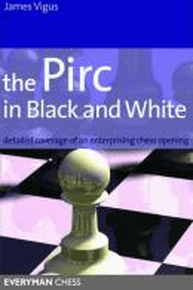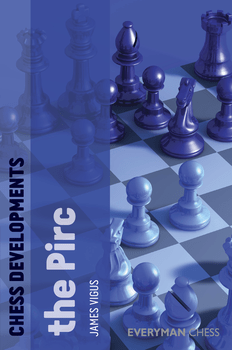| Nivå | C-D |
| Utgivelsesdato | August 2012 |
| Forfatter | |
| Pris | 235 NOK |
Chess Developments: The Pirc
"Endelig en ny Pirc-bok." IM James Vigus følger opp sin anerkjente "The Pirc in Black and White" fra 2007, og de 50 nye mønsterpartiene er spilt i årene 2007-12.
Denne nye boka kan også fungere som en konsentrert innføringsbok i Pirc (1 e4 d6 2 d4 Sf6 3 Sc3 g6) for spillere på et visst nivå, antagelig med ratingstyrke fra omlag 13-1400 og oppover.
Forordet
When I began work on this project, I was concerned that I might not find sufficient games of interest. A couple of years on, it’s hard to imagine a more groundless fear! Those I initially selected as main games were often moved into the notes as I worked through the embarrassment of riches that has greeted Pirc devotees in the last few years. That most creative of players, Vassily Ivanchuk, has taken up the Pirc as a weapon of choice when playing for a win with Black against 1 e4, with predictably impressive results. Vladimir Kramnik, who has been known to struggle with White against the Pirc, recently saw the light as well and likewise began to employ our opening in top-level tournaments. The Pirc has another elite champion in Shakhriyar Mamedyarov, while further big names including Alexander Grischuk, Vugar Gashimov, Veselin Topalov, Peter Svidler, Levon Aronian and Vadim Zvjaginsev have dabbled in it occasionally. Thanks to the efforts of such players, as well as of long-term exponents at ‘ordinary’ grandmaster level, such as Fernando Peralta and Vitaly Tseshkovsky, I can confidently promise readers both pleasure and instruction in the pages of Chess Developments: The Pirc.
The Pirc attracts these stars for essentially the same reason that it may be recommended at lower levels. Its theoretical status is currently very respectable (more so now than five years ago when I made a special effort to rehabilitate several lines in my first book on this opening), but this reliability does not come at the price of allowing forced draws or needing to memorize reams of analysis merely in order to ensure survival in certain critical lines. Independent-minded players continue to benefit from this scope for improvisation and innovation in the early stages. This book provides an up-to-date survey of the Pirc using fifty annotated games, focusing in special depth on several fashionable lines. Unlike an opening such as its thematic cousin the Sicilian Dragon, however, the Pirc doesn’t have any main highways in which crucial novelties are introduced every few months or so; instead, black players need to treat a large range of possible replies with equal care and attention. For this reason, I have covered almost the whole spectrum of the opening in this book, omitting only minor lines that have seen hardly any action in the past five years (such as 4 Bc4, 4 Bf4 and 4 Be2 intending g4 or h4). I frequently provide longer game fragments than is strictly necessary for a theoretical assessment, in order to give readers a full sense of the creative possibilities available.
This book is thus primarily a battle manual for modern tournaments, designed both for established Pirc players and for those who are taking up the opening for the first time. Whilst there is much analysis offered for critical study, the usual Notes, Tips, Warnings and Key Development icons will, I hope, make for enjoyable reading.
At the same time, this book updates my comprehensive survey of Pirc theory, The Pirc in Black and White (Everyman Chess 2007). In the present book, I refer frequently to this earlier work using the abbreviation TPIBAW. These references are designed to assist the orientation of readers who own both volumes, while also helping ‘new’ readers to decide whether or not they need TPIBAW in their library. Chess Developments: The Pirc is a fully self-contained book – but summaries of earlier theory as well as established strategic concepts are necessarily brief, and in this sense it is also a sequel to TPIBAW. As always, I have aimed to provide objective analysis and assessments, not merely to cheerlead the black cause. Nevertheless, the choice of material in the present book has mainly been directed by what seems to me, as a lifelong Pirc player myself, to fulfil the needs of black players. The present book also includes some references to another book published by Everyman Chess in 2009: Dangerous Weapons: The Pirc and Modern, by Richard Palliser, Colin McNab and James Vigus. However, the overlap here is likewise negligible, with only one main game (no.6) common to both books.
The Bibliography lists works relevant to the Pirc since 2007, as well as a selection of the older texts that I continued to consult while preparing the notes for this book. Thanks to one of the swings typical of chess fashion, I have had far fewer white repertoire books to deal with this time; with queen’s pawn openings currently in ascendency at the highest level, only the white repertoire work by Andrew Greet has made any significant impact on Pirc theory. By far the most useful source has been the ChessPublishing website, where John Watson has put the Pirc (and TPIBAW) under the microscope in many updates. I contributed some updates as Watson’s guest, and since then Pirc annotations on this website have appeared by grandmasters Neil McDonald, Milos Pavlovic and Gawain Jones.
One general development in approaches to the Pirc during the past five years stands out. This is the rise of Schmid Benoni structures (compare 1 d4 c5 2 d5 Nf6 3 Nc3 g6 4 e4 d6, which incidentally is not a bad way for a Pirc player to consider meeting 1 d4). Benoni formations have enjoyed something of a renaissance of late, as the first volume in Everyman’s Chess Developments series explored, and it’s remarkable how often they will form the basis for successful queenside counterattacks from Black in this book. From White’s point of view, meanwhile, I’m struck by the recent success of 4 Bg5, an aggressive approach developed in the 1960s by American players such as Robert Byrne. If you’re a newcomer to the opening who is eager for an up-to-date anti-Pirc repertoire, you might wish to turn straight to Chapter Five.
I would like to thank John Emms for the material, advice and patience with which he has supported my work on this book, and Richard Palliser, from whom I have learned much about the Pirc especially while we worked together on the Dangerous Weapons project. Thanks also to my mother, and to my parents-in-law, for housing a ‘writer in residence’ at various times during university vacations.
James Vigus, Rimini, June 2012
| Innbundet? | Nei |
| Type | Bok |
| Språk | Engelsk |
| Antall sider | 256 |
Produktet er en del av serien Chess Developments åpningsbøker
En ny serie åpningsbøker fra forlaget Everyman, som ligner en logisk suksess. På den ene siden innholdsrike, ganske tradisjonelle åpningsteoribøker, men viser seg ved nærmere granskning å ha en veldig klar profil på å behandle utviklingen i åpningen gjennom de senere årene. Det blir dermed en aktuelle status om de åpningens ulike viktige varianter.
Se også
-

The Pirc in Black and White Detailed coverage of an enterprising chess opening
KjøpEn omfangsrik og svært aktuell åpningsbok fra forlaget Everyman. Forfatteren hevder at Pircs forsvar (1 e4 d6 2 d4 Sf6 3 Sc3 g6) beviselig scorer bedre for svart enn mange mener med fordelsvarianter for hvit.
- Pris
- 295
- Nivå
- B-D
- Av
- Utgivelsesdato
- April 2007

